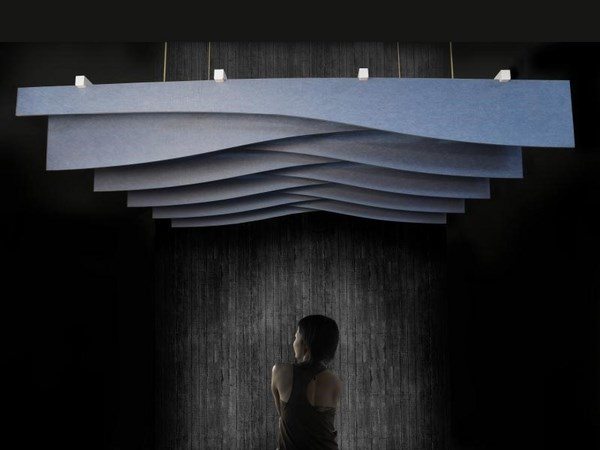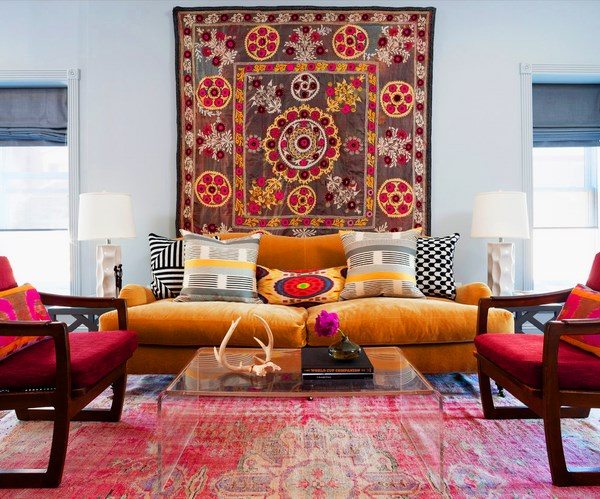How to soundproof a room? How to reduce noise pollution and create an effective sound barrier? When home insulation is discussed people usually think of heat and energy insulation, as those are major considerations and the negligence could cost a lot of money. Sound insulation, unless your home is near an airport, a railway station or a highway, is seldom a prime concern but could be a serious and more than just annoying problem. Noise affects human health and has a negative effect on concentration, productivity, rest and the lack of peaceful sleep results in constant fatigue, high levels of stress, and even worse diseases.
When building a new home you could think of sound insulation before you moved in. In apartment buildings, however, it is much more complex to open the walls, floor or ceiling and add adequate sound insulation. Let alone, that you may need permits, you have to comply with local building codes, the management of the building and the avalanche of complaints from the neighbors for the period of such a major makeover which inevitably involves construction activities. Further to all this, inside our home, we produce noise which can be disturbing not only to neighbors but to you or your small children. For example, teenage children like to listen to music loudly or you teenage son is learning to play piano, violin or drums – you will hear the sound all over the apartment and it is very likely that your neighbors will hear it as well. A baby crying at night may wake up everyone and when elder kids need to go to school or the father – to work, they should have had a good rest during the night. Soundproofing a room is not an impossible task, however, and we shall look at the different options which will allow you to create a peaceful and tranquil place for yourself and your family.
How to soundproof a room – identify the noise source
Identifying the noise source is one of your first tasks when you wonder how to soundproof a room. As per experts, you also need to know whether you want to deflect sound waves or absorb sound waves and as a third option, which requires a more professional approach is to clarify the sounds, which means reduce echo, for example. This option is most popular for music rooms or home music studios where the quality of sound is a prime concern.
Professionals divide group noises in four groups – Impact noise, which is a result of hitting a wall, sound from shoes on hard floor surfaces, sounds from moving furniture, etc. Airborne noise is a result of loud conversations, a crying baby, loud music or TV, or a barking dog. Structural noise can be transmitted over a very large distance. Those ate noises from pipe vibrations, for example. Echo is an acoustic noise which is typical for new buildings and unfurnished rooms.
When you want to create an effective sound barrier, you must interrupt the path through which sound is transmitted. Sound travels in waves and any barrier that interferes with this movement weakens the sound. Obviously, the more dense the barrier is, the less sound. To have an efficient soundproofing means that you need to soundproof the floor, all walls and ceiling. Additional layers of drywall or wall insulation are the two most recommended approaches to ensure a good soundproofing. These could be quite time, labor and finance consuming solutions, however so if you want to soundproof a room without breaking the bank, we shall give you some useful ideas to minimize or block noise in the home.
How to soundproof a room ceiling?
Airborne and impact noise are the most common problems as both types enter your home through the ceiling, joists and beams which means that the noise source could be several levels above your apartment. The goal is to reduce that noise, whether absorbing it or interrupting it, and there are several ways to do it. Soft materials and dense materials like drywall, MDF, fiberglass insulation, vinyl sheeting are some of the way to deal with the noise. Adding a second layer of ceiling, i.e. creating a gap, is another way to deal with the problem. Install acoustic tiles is a great option Ceiling acoustic tiles are available on the market in a variety of designs. Make sure you choose a reputable manufacturer so that keeping out sound waves is efficient. Of course, it will be a good idea to consult with a professional for your particular situation as they will be able to give you a good advice on the different options, types of acoustic tiles, soundproof ceiling tiles and other alternatives.
How to soundproof the walls?
There are many ways of soundproofing the walls. Some involve opening the walls and adding insulating materials, others involve more creativity, especially when you cannot or do not want to deal with foam insulation or other types of insulating materials. Obviously, when walls are under construction, you have a variety of options to choose from, but when you are faced at the challenge to soundproof an existing wall, we come to original and creative solutions which are way less expensive and, sometimes, even more effective than traditional methods. Here are some ideas how to soundproof the walls of a room.
The general rule of adding mass to existing walls can be applied in many ways. You can choose special soundproof paint or soundproof wallpaper which you can find on the market and those will help you reduce some of the noise. However, having in mind that both of these are quite thin, you should not expect a serious result and an adequate soundproofing, despite that the products are being advertised as highly efficient. Typically, soundproof wallpaper is as thin as regular wallpaper with a thin layer of foam.
Soundproofing your walls with acoustic tiles or acoustic panels is another solution. They are designed to absorb sound and improve the sound inside a room, which makes them a good choice for home theaters, music studios, rehearsal rooms, etc. Acoustic tiles and panels are also very helpful in reducing sound transmission through walls. In addition, they come in a huge variety of colors, sizes and thickness which allows numerous decorative options. You can arrange them in different patterns to create an accent wall and enhance the visual appeal of the interior. Some manufacturers offer custom-printed fabrics which is a great opportunity to turn acoustic tiles into an original piece of wall art.
Wall panels are an excellent and exceptionally stylish solution to soundproof walls. You can opt for tufted wall panes or padded wall panels and install them as an additional wall decoration. Such panels offer an incredible visual aesthetics and make any space look luxurious and elegant. Wall panels are the perfect acoustic shield which can successfully protect you from the noise coming from the outside and reduce echo in the room. In terms of design and appearance, this solution offers the most opportunities to add texture and color to the interior in an easy way in any room of the home – living room, dining room, home theater, home office or bedroom. Typically, tufted wall panels are used in bedrooms, where the need of a quiet and peaceful atmosphere is decisive for a good rest. Some homeowners prefer an oversized tufted headboard while others opt to use the panels on the entire wall. Either way the panels add intimacy, coziness and add a lot of style to the bedroom. A great advantage is that tufted or padded wall panels can be used in both large and small bedrooms and will add tremendously to the overall appearance of the room.
Cork tiles offer the advantage that they can be installed not only on the walls, but on ceilings and floors as well and will give a unique look to any room. Installed on the wall, cork tiles offer exceptional heat and cold insulating properties and in addition, they have great soundproofing, acoustical insulation & anti-vibration properties. In terms of visual appeal cork tiles add texture, softness, richness, character and warmth to the room, they feel soft to the touch and being a sustainable material adds another plus to their many advantages. You can find cork tiles in a wide variety of patterns, shades, styles and thicknesses so that they will not only soundproof your wall but compliment the decor of the room as well.
Wood wall panels or planks are another option for soundproofing walls. The exceptional insulating properties of wood can be used to absorb sounds and add to the visual aesthetics of the room. A wood wall is always an eye catcher and you can use almost any type of solid wood – from salvaged and reclaimed wood to trendy wood wall panels. In terms of visual appeal, wood has the advantage that it can be stained or painted in any color so that it blends with the existing home interior or in a contrast color if you wanted to create a visual contrast.
One of the easiest ways to soundproof a wall is to use furniture pieces. Floor to ceiling bookshelves or cabinets are a good solution which adds layers to the wall and blocks the noises. This can be done in living rooms, bedrooms, home offices, etc.
Rugs and soundproof curtains on the walls sound like an unusual decision, but it works. Of course, you cannot expect a great effect yet if you have no other options, hanging a soundproof curtain or a carpet will greatly reduce the noise. In terms of decoration, this can be a dramatic and unique wall decor which will add to the visual appeal of the room. For example, a dense curtain behind the bed will look very elegant as a bedroom decor while a colorful exotic carpet can be not only functional soundproofing but an eye catching decorative element.
A vertical garden or a living wall is another creative solution when you want to soundproof a wall. The layers of soil and the plants will provide protection against sound waves and you will have a spectacular accent wall. This is a good idea for living rooms, bathrooms, kitchen and open plan living spaces.
How to soundproof the floor?
Hard floors – solid wood floors, tile floors, laminate floors, terrazzo floors, etc. – are a big source of noise as hard surfaces reflect sound waves but no one would expect that home occupants will stop walking around. Soundproofing the floor can be done by adding an underlayment which helps cut the impact and airborne noise. When you need to soundproof an existing floor, using sound absorbing materials is the way to go. Thick rugs and shaggy rugs are a good option. You can add an additional pad under the rug for extra sound absorption. Floor cushions and beanbags will also help block noises and will also insulate the floor.
Windows and door soundproofing ideas
When we discuss how to insulate a room, we need to pay attention to windows and doors. Soundproofing the windows will significantly reduce noises coming from the outside and people who live in homes near streets with heavy traffic know how irritating the constant noise can be. Sound-blocking curtains may be all you need. Even heavy drapes will help you block the noise from the street. It will be better if you use multiple layers of fabric. This will have a better sound blocking effect and you can use the window treatment as an element of the interior design. For example, a combination of heavy drapes or curtains like velvet with roman blinds or a sheer fabric looks very elegant, rich, sophisticated and stylish. In addition, heavy curtains will absorb interior noises and sounds, which is an important consideration.
Soundproofing doors, whether interior or exterior, is another option that homeowners need to consider. Why door soundproofing is important? Doors are large openings in the wall and if the door frame is not properly sealed, noise waves travel without a problem. You know that most interior doors are with a hollow core which means they have very poor soundproofing properties. Changing your interior doors is costly and laborious but there are other cost-effective, time, money and energy saving ways to soundproof your doors.
Installing weather strips around internal and external doors is the easiest, the cheapest and effective way to reduce noise. These are adhesive-backed high-density foam tapes and it takes just minutes to install them. You will be surprised how much work they do!
Caulking is another way to improve the soundproofing of your doors. Use acoustic sealant and caulk around the door frame and trim.
However, if you choose to replace your existing hollow core interior doors, it is advisable that you opt for solid core options like particleboard-core, composite-core, or solid timber doors.
An effective door soundproofing is to use acoustic panels for doors. You can find acoustic blankets for doors on the market as well. In case you are not satisfied with their appearance, think about leather doors. They look really beautiful and without any doubt, add a feeling of grandeur to the home interior.
How to soundproof a room – useful and practical soundproofing techniques
The goal when soundproofing a room is to reduce noise. We pointed out many different ways to soundproof your walls, ceiling, floor, windows and doors. However, there are some easy ways to reduce the “noise makers” in our home.
Empty spaces create echo so filling them will prevent or significantly reduce the echo in your rooms. Hard surfaces reflect sound thus raising the noise levels. Soft furniture will help you fight the noise. Floor cushions, thick or shaggy rugs, dense curtains and drapes – all these absorb sounds, so take advantage of that to create a peaceful and quiet home.
Home appliances are one of the greatest “noise-makers” in any home. Whether we like it or not, this is a fact. Of course, this does not mean that you have to throw your dishwasher or washing machine, air conditioner or refrigerator but make sure that you have checked the specifications of the appliances when you buy them. Most manufactures offer quieter models, and even if they cost a bit more, it will be worth the investment.



















